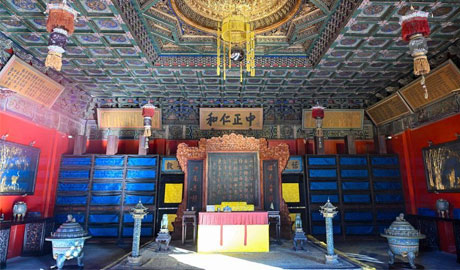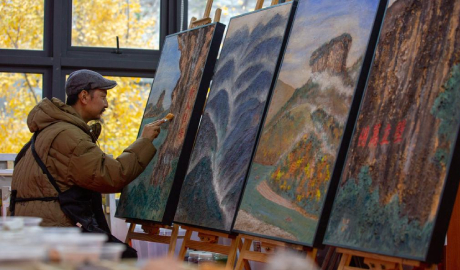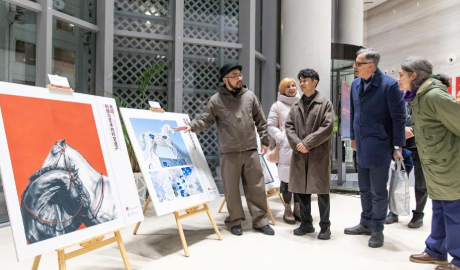

Not long ago, I went to Zibo of Shandong for the wedding of a good friend. Apart from sharing the joy of the newlyweds, I also tasted the most authentic Zibo barbecue.
It’s easy for the barbecue of a place to be popular for a few days, but to make it a catchy business card, efforts of the local party committee and government must be indispensable. From setting up a barbecue association to controlling prices, from food safety to security patrols, the local government introduced a package of measures.
People come to Zibo because of the vibe there, but they leave the place with a memory of comfort. The popularity of Zibo is a strong footnote to its perfect dealing with vitality and order.
Chinese-style modernization is a systematic project that involves the proper handling of a number of major relationships such as the one between vitality and order – an eternal topic of human development along with the changes of human society. Vitality and order are also the two basic dimensions of the modernization process entwined in a mutually affecting relationship.
I grew up in a small town in southern Anhui Province, where the Yangtze River meanders past our home, and we have a well-developed water system with numerous lakes. The locals are fishermen and farmers who irrigate their land with the river water. It’s the Yangtze River that nourishes the local soil and people. But the older generation say that such good life is attributable to the strong dams along the river, because in the past during the rainy season in summer, much of the village would be waterlogged almost annually.
Some Western scholars say that “the journey towards modernization is also the easiest way to lose it”. What does this mean? It means that in the process of modernization, a country is extremely vulnerable to conflicts and turmoil, which can lead to social stagnation and setbacks in modernization. Such a “modernization theory” has indeed played out in some countries.
Over the past 70 years since the founding of New China, we have seen dramatic and unprecedented social changes. How is it that the Chinese society has been run in an orderly fashion despite such drastic changes? One important factor is our new political party system. On the one hand, it gives full play to the vitality of parties in participating in politics, and takes into account the specific interests of all strata and aspects of society; on the other hand, we have been able to gather consensus, mobilizing the democratic parties to work towards the same destination in an orderly manner within the established political framework.
Throughout the course of modernization in the world, the transition from a traditional to a modern society is often accompanied by profound changes in social structure, social relations, social psychology, etc. Handling well the relationship between vitality and order is in fact a world-class challenge.
So, how to promote Chinese-style modernization while maintaining a dynamic balance between vitality and order?
I recall my research trip to Fengqiao of Zhejiang some years ago. The name “Fengqiao” is familiar to everyone.
The year 2023 marked the 60th anniversary of Comrade Mao Zedong’s instruction to study and scale up the “Fengqiao Experience”. Prior to the opening of the Asian Games, General Secretary Xi Jinping visited the place and called for pursuing and developing the “Fengqiao Experience” in the new era.
In the context of promoting Chinese-style modernization, vitality and order represent the value goal and ideal picture of governance modernization. It’s important to maintain order in vitality and stimulate vitality in order. Chinese-style modernization should and can achieve a state of governance that is lively, orderly, but not chaotic.
The “Fengqiao Experience” of the new era aims at such a state of governance. On the one hand, we should give full play to the central role of the Party’s leadership, resolve contradictions at the grassroots level, and maintain social stability. On the other hand, we need to support the positive interaction of the grassroots government, neighborhood committees, social organizations and multiple social governance bodies to effectively enhance the social vitality index.
I remember that on my research trip, I interviewed local cadres with the question “What is your greatest experience working on the front line of Fengqiao?”
I was moved by the answer of one of them: “We have a local attraction in Shaoxing, the canopy boat, which tourists love to experience. The boat is powered by either pedals or oars. Practicing the ‘Fengqiao Experience” on the front line is like a boatman navigating with both tools. You need the pedal to increase the propulsion, and also the oar to control the direction.”
Indeed, the pedal gives you vigor, and the oar gives you order. When combined, they form the wisdom and art of the helmsman. Our work and life are never short of dialectic examples of vigor and order. China today is vigorously surging ahead while maintaining harmony and stability.
The Chinese communists are most dialectical, placing vitality in order and building order on vitality. China’s practice has fully proved that vigor and order can go hand in hand, and that vitality and order can be organically unified. Only by harmonizing and balancing the vitality and orderly operation of society can we ensure that Chinese-style modernization marches far and wide.

Lianyungang port welcomes largest group of S. Korean travelers under China's visa-free policy

Hall of Mental Cultivation of the Palace Museum reopens to public

Wuyi rock pigment painting in China's Fujian infuses modern artistic elements into tradition

China-Serbia digital art exhibition explores time, space, heritage

点击右上角![]() 微信好友
微信好友
 朋友圈
朋友圈

请使用浏览器分享功能进行分享
